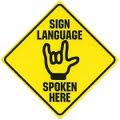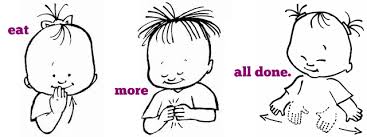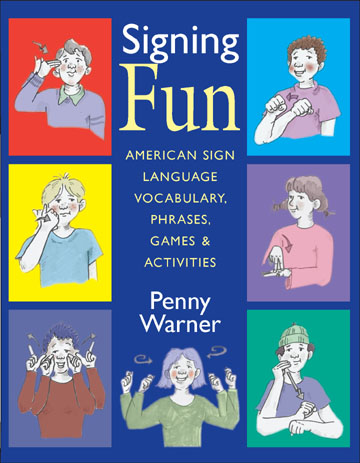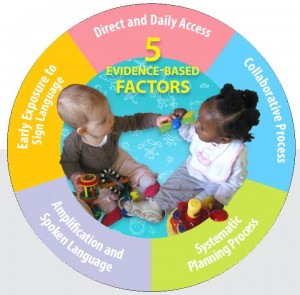Related Products
For Parents
Related Teacher Tools Takeout Items
ASL Development

ASL Stages of Development
is a 2-page list of skill development stages of children from 3 months through 5-6 years.
Guide to the ASL Development Observation Record
is a 12-page detailed observation that includes the 2-page list of stages.
These materials were developed by the Early Childhood Education program at the California School for the Deaf in Fremont to document the ASL language development of deaf children from the time they enter early intervention/early childhood to kindergarten.
The goal is to identify the language strengths and needs of each child and to document progress over time. It also serves as a criterion-referenced hierarchy to guide teacher in assessing their own role as language models and how they use language with children. Kudos to CSD for a wonderful assessment and planning resource!
K-12 ASL Content Standards
developed by the Clerc Center at Gallaudet University. The ASL Content Standards help for planning and monitoring ASL development in children who are deaf or hard of hearing visual communicators.
A Good Start: Suggestions for Visual Conversations with Deaf and Hard of Hearing Babies and Toddlers
suggests research-based techniques for communicating with young children with hearing loss. Deaf children of Deaf mothers typically have age appropriate language levels at 18 months as compared to children with hearing loss who have hearing parents. This study considered what the Deaf parents are doing that results in these higher outcomes. Primary differences related to the
way that parents got the attention of their infant/toddler before communicating. These attention getting techniques can be of benefit to any family of a child with hearing loss, regardless of the communication option used.
Through Deaf Eyes
is an almost 2-hour video that portrays the history of deaf education and views of people who themselves are deaf. This video, or viewing portions with your students, may be valuable in Deaf culture studies and self-advocacy considerations.

Setting Lang in Motion: Family Supports and Early Intervention for Babies Who Are Deaf or Hard of Hearing.
This resource was developed collaboratively between the Clerc Center and the Deaf and Hard of Hearing Program at Boston Children’s Hospital. With this resource, parents, educators, and professionals have
free access to seven online modules which share information critical to promoting early language acquisition for young children who are deaf or hard of hearing. The topics covered in these seven modules include: early hearing screening and evaluating, understanding how the ear works, hearing aids, cochlear implants,
using sign language for communication, communication at home, and parenting a deaf or hard of hearing child. Find out more
here.
This free online network is designed especially for early intervention professionals. It provides one centralized place to access evidence and recommendations to guide your practice in supporting language and communication development for young children who are deaf or hard of hearing. The network also provides an opportunity to see what early intervention providers are doing to implement these recommended practices.
Visit the network and find out about the 5 evidence-based factors identified as critical to early language acquisition.
Gain the knowledge and skills you need to effectively promote linguistic development for young children who are deaf and hard of hearing.
Webinar: Maximizing Language Acquisition – ASL & Spoken English
Provided at no cost by Gallaudet’s Laurent Clerc National Deaf Education Center,
Maximizing Language Acquisition provides an evidence based rationale for supporting language acquisition in both American Sign Language and spoken English for young children who are deaf or hard of hearing. The webinar describes the results of research on language acquisition and clarifies misconceptions in deaf education. To learn more about the webcast click
here.
Signing with Babies and Children : A Summary of Research Findings for Parents and Professionals.
By Claire Vollotton, PhD, commissioned by Two Little Hands Productions (2011). As they state:
‘This white paper is for you – the many parents, teachers, health professionals, social workers, students, and writers who have asked us for unbiased information that can be used to inform practices and shape professional opinions. We are pleased to be sharing this paper with you and we encourage you to pass it along to anyone you think may benefit from it.’
Information about an App to Learn Sign Language: Sign language is the preferred choice for some families and/or the best mode to learning for some children. It isn’t always easy to learn though within a busy family’s schedule. The information about the
Baobob App
designed by Gallaudet University. It is the first of a series of three bilingual storybook apps, developed to help language acquisition and reading in all young children; in particular for those who are deaf and hard of hearing. This app is unique in the world since it was built upon findings of extensive research done on both hearing and deaf bilinguals. Past research demonstrated that early visual language experience with ASL aids reading acquisition in English and offers other important advantages for a deaf child’s linguistic, communicative, cognitive, academic, literacy, and psychosocial development.
ASL Development Tools from Departments of Education and Other Resource Sites
- Developed by West Virginia Department of Education
- Developed by Wyoming Instructional Network
- Center for Deaf and Hard of Hearing Education, Indiana
- ASLCIA – American Sign Language Curriculum, Instruction, Assessment
- Assessment Toolkits from Gallaudet University
- ASL Education Center
- Pictures of ASL signs
- Type in word for video of sign
- Practice for fingerspelling
- Stories in ASL with subtitles
- Curriculum (ASL University)
- Music videos by children using ASL
- Uplifting, inspiring and great to share with peers, families, teachers!See apps and other sign language learning resources
here.
-
Website resources for learning, practice and fun
Updated January 2024.


